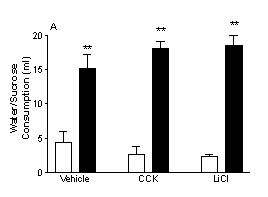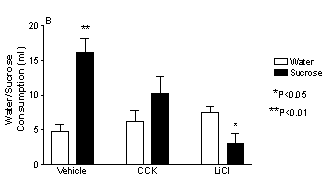| pA2 online © Copyright 2004 The British Pharmacological Society |
070P
University of Bath Summer Meeting July 2004 |
|
Does exogenous peripheral cholecystokinin mediate its suppressant effect on feeding by producing malaise? J. D. Patel & I.S. Ebenezer. Neuropharmacology Research Group, School of Pharmacy and Biomedical Sciences, University of Portsmouth, Portsmouth, PO1 2DT, U.K |
|
Gibbs et al. (1973) demonstrated that i.p. administration of cholecystokinin (CCK) reduced food intake in hungry Male Wistar rats . They showed that doses of CCK in the range 2 – 8 µg kg-1 did not reduced water intake nor produce “bait-shyness” in these animals and concluded that the effects on CCK on food intake were behaviourally specific and not due to drug-induced malaise. They therefore proposed that endogenous CCK released from the small intestine during a meal acts in a feed back manner to produced satiety. However, experiments in other animal species have suggested that exogenous peripheral CCK suppresses food intake by an aversive action (see Baldwin et al., 1998). Moreover, a sensitive method of measuring water intake has revealed that doses of CCK as low a 2 µg kg-1 decrease water consumption in thirsty rats. The present study was therefore undertaken to investigate the effects of CCK in a conditioned taste aversion experiment (CTA) in rats (see Ebenezer, 1990) to examine whether CCK could elicit its hypophagic effects by producing malaise.
Male Wistar rats (n=24) were deprived of water for 16h a day and were divided into a vehicle treatment group (n = 8), a lithium chloride (LiCl) treatment group (n=8), and a CCK treatment group (n=8). Each animal was given 3 daily training sessions where they were presented with tap water and sucrose solution (12%w/v). During the third training session the total intake of tap water and sucrose solution (SS) was measured after 15 min. The next day, the rats were given 15 min access to SS and were then injected i.p. with either vehicle, LiCl (100 mg kg-1) or CCK (2 µg kg-1) according to their designated treatment groups and returned to their home cages. 24 h later they were presented with water and SS and their intake measured. The data from was analysed by the paired t-test.
Fig. 1A shows that on the 3rd training session, the rats in all 3 groups displayed a preference for SS compared with water. During the retention trial (Day 5) similar results were obtained for the saline group. However, when consumption of SS was paired with injection of LiCl, a known aversive agent (Ebenezer et al., 1992), the rats showed passive avoidance of SS (Fig. 1B), presumable because they associated the aversive effects of LiCl with drinking SS. Similarly, the rats injected with CCK displayed a marked reduction in the consumption of SS on Day 5 compared with Day 3. Moreover, there was no significant difference in their consumption of water or SS on Day 5. These data suggest that CCK (2 µg kg-1; i.p.) produces taste aversion in a CTA experiment and adds further support for the view that peripheral exogenous CCK reduces food intake in animals by producing malaise (Baldwin et al., 1998). These finding have important implications for the CCK-satiety hypothesis.


Fig. 1A. Water and SS intake on Day 3. Fig. 1B. Water and SS intake on Day 5.
Baldwin, B.A. et al. (1998) Prog. NeuroBiol., 5, 477 – 507
Ebenezer, I.S. (1996) Proc. Royal Soc. B., 263, 91 – 496
Ebenezer et al. (1992) Gen. Pharmacol., 23, 75-379
Gibbs, J. et al. (1973) J. Comp. Psychol., 84, 488 – 495